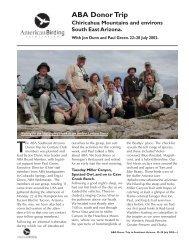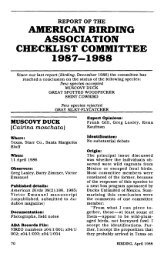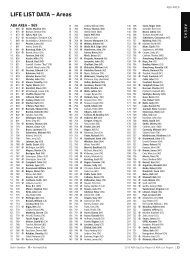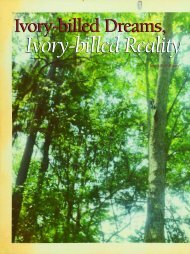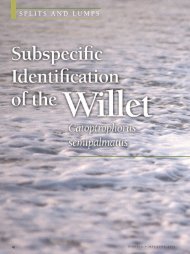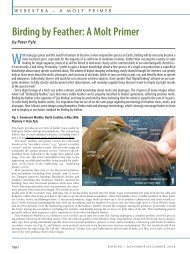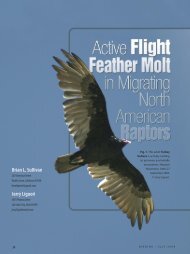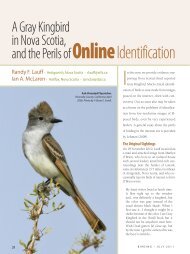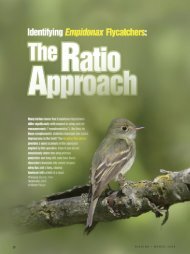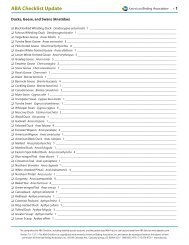Photo Essay: Redpolls from Nunavut and Greenland visit Ontario ...
Photo Essay: Redpolls from Nunavut and Greenland visit Ontario ...
Photo Essay: Redpolls from Nunavut and Greenland visit Ontario ...
- No tags were found...
You also want an ePaper? Increase the reach of your titles
YUMPU automatically turns print PDFs into web optimized ePapers that Google loves.
PHOTO ESSAY: REDPOLLS FROM NUNAVUT AND GREENLAND VISIT ONTARIOspecies simultaneously among gatherings ofthe more expected nominate Common Redpoll<strong>and</strong> exilipes Hoary Redpoll.On 8 January 2011, Michael Butler, payingcareful attention to redpoll flocks in his backyardat Marathon, <strong>Ontario</strong>, on the northshore of Lake Superior, photographed aHornemann’s Redpoll. In reviewing his images,Butler noted that one bird in the backgroundappeared to be a Greater Redpoll, <strong>and</strong>another in the foreground was an exilipesHoary (Figure 1). Experts in the identificationof redpolls, Ron Pittaway <strong>and</strong> MichelGosselin, agreed: all four taxa were visible—the first time the four North American taxawere known to have been photographed together!Following Butler’s discovery, it becameclear that redpolls of all sorts had madeit to northeastern <strong>Ontario</strong> as well, <strong>and</strong> Br<strong>and</strong>onHolden made his way to Matheson on 18February 2011, to discover at least fiveHornemann’s <strong>and</strong> many Greater <strong>Redpolls</strong>among redpolls flocks at feeders. SouthernNew Engl<strong>and</strong> <strong>and</strong> upstate New York hadscattered reports of Greater <strong>and</strong> Hornemann’s<strong>Redpolls</strong>, <strong>and</strong> many birders there got to observethese big redpolls for the first time.Along with many other web-based conversations<strong>and</strong> shared images, Holden’s <strong>and</strong> Butler’swebsites, full of fine images of thesebirds, became the impetus for the present<strong>Photo</strong> <strong>Essay</strong>.In the history of North American Birds <strong>and</strong>its antecedent journals, the little-knownHornemann’s Redpoll has been mentioned infrequently,<strong>and</strong> black-<strong>and</strong>-white photographshave been published only twice, <strong>from</strong> Québec(Aubry et al. 1988) <strong>and</strong> possibly Pennsylvania(Brinkley et al. 1994). Generally acceptedrecords of Hornemann’s Redpoll extend southto Maryl<strong>and</strong> <strong>and</strong> west as far as Michigan <strong>and</strong>Manitoba, whereas records of exilipes HoaryRedpoll extend south to Virginia <strong>and</strong> muchfarther to the west, with records <strong>from</strong> SouthDakota, Nebraska, Wyoming, Idaho, Washington,<strong>and</strong> Oregon. Greater Redpoll has beendocumented in New Engl<strong>and</strong> <strong>and</strong> the northernGreat Lakes region, with outlying recordsextending to southern New York <strong>and</strong> NewJersey; there are also single records <strong>from</strong> Colorado<strong>and</strong> Maryl<strong>and</strong>. Pittaway (1992) reportsthat Greater <strong>Redpolls</strong> are more common thanHoaries during some winters in southern <strong>Ontario</strong>.The relative abundance of Greater Redpollin the northeastern United States is notas well understood.With the rise of Internet-based communication,numerous observers have posted imagesof redpolls, including Hornemann’s <strong>and</strong>Greater, <strong>from</strong> their areas, along with observationsabout redpoll identification. As oftenoccurs, many of the formerly active hyperlinkshave become inactive, <strong>and</strong> some of thediscussion that remains archived in scatteredplaces includes misleading material <strong>and</strong> errors.There are numerous published articleson redpolls <strong>and</strong> their identification, <strong>and</strong>some are readily available <strong>from</strong> their publishersor are even archived online. Some of theseare based on scientific studies, but manywere written by people who witnessed a redpollirruption in their areas. During the winterof 1993-1994, for example, Dave Czaplak(1995) studied hundreds of redpolls at hisGermantown, Maryl<strong>and</strong> feeders—<strong>and</strong> documentednot just 17 exilipes Hoary <strong>Redpolls</strong>but also at least one each of Greater <strong>and</strong>Hornemann’s. In <strong>Ontario</strong>, Pittaway (1992)summarized what was known about theidentification of North American taxa basedon his extensive encounters with redpollsduring irruptions in Canada. In the UnitedKingdom, a 1984 irruption of nominateCommon <strong>and</strong> exilipes Hoary <strong>Redpolls</strong> wasthe occasion for a paper treating differencesbetween those taxa (Lansdown et al. 1991),<strong>and</strong> other authors have followed suit aftersubsequent redpoll flights in the UnitedKingdom (Riddington et al. 2000, Pennington<strong>and</strong> Maher 2005).Using Michael Butler’s photographs <strong>from</strong><strong>Ontario</strong>’s Thunder Bay District <strong>and</strong> Br<strong>and</strong>onHolden’s images <strong>from</strong> the Cochrane District(near the Québec border), this <strong>Photo</strong> <strong>Essay</strong>showcases the High Arctic redpolls amongtheir smaller relatives <strong>and</strong> also illustratessome distinctions between Hoary <strong>and</strong> Common,whose identification continues to providechallenges. We look first at distinctionsbetween exilipes Hoary <strong>and</strong> nominate CommonRedpoll, then at differences betweenHornemann’s Redpoll <strong>and</strong> exilipes Hoary Redpoll,<strong>and</strong> lastly at differences between GreaterRedpoll <strong>and</strong> nominate Common Redpoll.Thankfully, Hornemann’s <strong>and</strong> Greater havevery dissimilar plumages, but a few of the imagesthat follow depict the two together.Redpoll identification: history<strong>and</strong> cautionary considerationsAlthough most field guides to North Americanbirds illustrate basic differences betweentypical adult Common <strong>and</strong> Hoary <strong>Redpolls</strong>fairly well, the field marks emphasized inthese guides must often be used in conjunctionwith subtler characters to make a strongcase for identifying many individuals. Redpollplumages have been critically described in theAmerican scientific literature since Coues(1861) <strong>and</strong> Ridgway (1901). Various authorshave recognized between one <strong>and</strong> six speciesof redpoll, though most recognize just two inNorth America, Hoary <strong>and</strong> Common, thesebeing distinguished chiefly by plumage featuresrather than measurements. Troy (1985)collected redpoll specimens (nominate Common<strong>and</strong> exilipes Hoary only) <strong>from</strong> Alaska tonorthern Québec <strong>and</strong> focused on streaking inundertail coverts, rump, <strong>and</strong> flanks as a wayto evaluate plumage variation in redpolls,which he treated as a single species. Thattreatment has not been followed by subsequentauthors, who treat Common <strong>and</strong> Hoaryas distinct species (Molau 1985, Knox 1988,Herremans 1990, Seutin et al. 1992, 1993,1995). Most authors indicate that differencesin streaking have some value when distinguishingthe generally less-streaked Hoary<strong>from</strong> the more-streaked Common, but all authorswho discuss field identification cautionthat some individuals may not be identifiableto species or subspecies.Knox <strong>and</strong> Lowther (2000b), for instance,indicate that nominate Common Redpoll(Figure 2) usually shows “broad streaks onundertail coverts” <strong>and</strong> a “rump normally withextensive streaks; adult male [exilipes] Hoary<strong>Redpolls</strong> have at most 1-3 hairline streaks onlongest undertail coverts.” Also in exilipes,the flanks <strong>and</strong> breast tend to show less streaking(<strong>and</strong> generally finer streaks on average)than in nominate Common, <strong>and</strong> mantlefeathers <strong>and</strong> scapulars tend to be paler, as dothe edges of upperwing coverts <strong>and</strong> secondaries.Finally, the upperparts tend toward white<strong>and</strong> gray in Hoary, toward buffy <strong>and</strong> brown inCommon, though some exilipes Hoaries havebuffy tones in the head <strong>and</strong> back (Knox <strong>and</strong>Lowther 2000b) <strong>and</strong> Hornemann’s frequentlyhave such tones (van den Berg et al. 2007).These general differences between thepalest, least streaked Hoary <strong>Redpolls</strong> <strong>and</strong> thedarkest, most heavily streaked Commons arehelpful when an observer is just gaining confidencein identifying redpolls to species. Asone begins to look carefully through largeflocks of redpolls, however, it becomes clearthat there are many birds that seem to be intermediatebetween the more stereotypicalCommon <strong>and</strong> Hoary <strong>and</strong> that differences inplumage appear to form a continuum, withsome individuals falling into a gray area notadequately treated in field guides. As Pittaway(1992, 2007) has emphasized, part ofthe reason for the extensive variation we observeis that each taxon shows plumage variationby age <strong>and</strong> sex—thus each has mini-V O L U M E 6 5 ( 2 0 1 1 ) • N U M B E R 2 207



